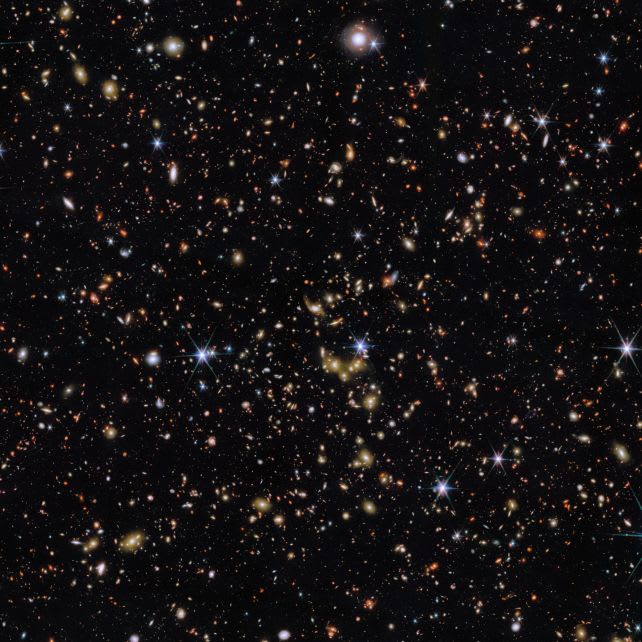
NASA’s
James Webb Space Telescope (JWST)
has captured a
mind-blowing deep-field image
from a small slice of the heavens, showing that almost every point of light is actually a galaxy.
This remarkable image, featured in the most recent research publication, appeared in
Astronomy & Astrophysics
, showcases galaxies that stretch back nearly
12 billion light-years
The information is part of the
COSMOS-Web survey
.
A Cosmos Brimming with Galaxies
The image released by
JWST
is no ordinary view of the night sky. Unlike typical stargazing, where we see primarily
stars
This picture is mostly comprised of galaxies, most of which are nearly as ancient as the universe itself.
universe itself
.
These galaxies are not mere points of light, but vast systems of stars, dust, and dark matter that have existed for billions of years.
The captivating aspect of this image lies in the remarkable level of detail captured within what appears to be an inconsequential part of the sky. The portion depicted covers barely more than
one-fifth the diameter of the Moon
, a space so minuscule that it might readily escape notice during typical observations. Nevertheless, inside that infinitesimal area, we observe
thousands of galaxies
.
JWST’s Unique Capabilities and What Makes This Image Special
A prominent feature of this image is how clearly JWST differentiates
foreground stars
from far-off galaxies. The telescope captures a distinct
diffraction spike pattern
in the light emitted by stars.
This pattern occurs when the light from a star bends around the telescope’s edges, creating sharp points of light. The galaxies, on the other hand, don’t produce this effect because their light is much more diffused. This helps astronomers clearly differentiate between stars and galaxies, providing more precise data on the distant universe.
The central focus of the image is a group of galaxies shimmering brightly.
golden light
. These galaxies are incredibly far away, with the light from this group having traveled
6.5 billion years
To contact us. This provides a sense of the universe’s age, emphasizing the vast amount of time it has taken for this light to reach our vision.
This unique
JWST-Hubble composite
The image depicts a period much nearer to the start of the universe.

The Function of the COSMOS-Web Survey
The
COSMOS-Web survey
drives this significant finding. Designed to catalogue clusters of galaxies, the survey enables scientists to gain deeper insights into galaxy evolution and their development over time.
cosmic web
This connection forms part of an extensive initiative aimed at charting the relationships among galaxies along with the unseen influences of dark matter and hydrogen that hold them together.
The universe isn’t randomly scattered with galaxies. They cluster together in
dense regions
, forming large structures connected by vast networks of
dark matter and hydrogen
.
Massive Galaxy Groups Revealed by JWST
JWST’s observation has also revealed some
massive galaxy clusters
. By combining JWST’s data with
X-ray observations
from the
Chandra X-ray Observatory
, astronomers have identified some of the most massive galaxy clusters ever seen.
These conglomerates are extensive and densely packed, housing an enormous quantity of galaxies along with substantial volumes of hot gas. This gas radiates heat.
X-radiation
, detectable by Chandra.
In total, an
international team of astronomers
, led by
Greta Toni
from the University of Bologna, has pinpointed
1,678 galaxy groups
within the catalog assembled using the most recent JWST data.
This catalog embodies merely a small portion of the cosmos, yet it offers a
awe-inspiring glimpse
into the vast architecture of the universe.
The Magnitude of the Universe and Our Tiny Existence
One of the most remarkable insights from this picture is how it underscores the immense scale of the cosmos. The section of sky depicted in the image represents merely
6.44 by 6.44 arcminutes
, and despite this, it includes more than a thousand galaxy groups.
To help understand this better, consider the following:
full Moon
appears roughly
30 arcminutes
Across the sky. This indicates that the captured section is remarkably tiny in comparison, but it brims with galaxies.
Astronomers think that for every star like this one, there could be additional ones.
small patch of sky
ought to disclose comparable discoveries — thousands of galaxies within areas just as minuscule as the region imaged by JWST.
Enjoyed this article?
Sign up for our complimentary email newsletter.
for engaging stories, exclusive content, and the latest news.
For more news like this, visit
Dailyexe
.





